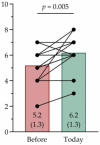User Experiences of the Cue2walk Smart Cueing Device for Freezing of Gait in People with Parkinson's Disease
- PMID: 40807870
- PMCID: PMC12349309
- DOI: 10.3390/s25154702
User Experiences of the Cue2walk Smart Cueing Device for Freezing of Gait in People with Parkinson's Disease
Abstract
Freezing of gait (FoG) impairs mobility and daily functioning and increases the risk of falls, leading to a reduced quality of life (QoL) in people with Parkinson's disease (PD). The Cue2walk, a wearable smart cueing device, can detect FoG and hereupon provides rhythmic cues to help people with PD manage FoG in daily life. This study investigated the user experiences and device usage of the Cue2walk, and its impact on health-related QoL, FoG and daily activities. Twenty-five users of the Cue2walk were invited to fill out an online survey, which included a modified version of the EQ-5D-5L, tailored to the use of the Cue2walk, and its scale for health-related QoL, three FoG-related questions, and a question about customer satisfaction. Sixteen users of the Cue2walk completed the survey. Average device usage per day was 9 h (SD 4). Health-related QoL significantly increased from 5.2/10 (SD 1.3) to 6.2/10 (SD 1.3) (p = 0.005), with a large effect size (Cohen's d = 0.83). A total of 13/16 respondents reported a positive effect on FoG duration, 12/16 on falls, and 10/16 on daily activities and self-confidence. Customer satisfaction was 7.8/10 (SD 1.7). This pilot study showed that Cue2walk usage per day is high and that 15/16 respondents experienced a variety of positive effects since using the device. To validate these findings, future studies should include a larger sample size and a more extensive set of questionnaires and physical measurements monitored over time.
Keywords: Parkinson’s disease; cueing; freezing of gait; freezing of gait detection; on-demand; self-activation; smart cueing; user experiences; wearable sensors.
Conflict of interest statement
M.v.d.E. and F.W. are part of the board of Cue2Walk International B.V. J.N. and E.E.H.v.W together form the medical advisory board of Cue2Walk International B.V. The other authors declare no conflicts of interest. The funder of this study had no role in the design of the study; in the collection, analyses, or interpretation of data; in the writing of the manuscript; or in the decision to publish the results.
Figures



References
MeSH terms
Grants and funding
LinkOut - more resources
Full Text Sources
Medical

